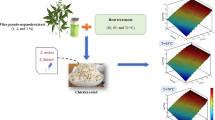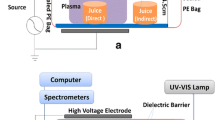Abstract
The response of Listeria innocua (surrogate for Listeria monocytogenes) to combined treatments involving moderate temperatures (57 to 61 °C) and the addition of different levels of citral (0 to 75 ppm) was assessed to obtain a minimally processed orange juice. The presence of citral notoriously increased the bactericidal effect of mild heating treatment. This effect did not depend on the amount of added citral at all assayed temperatures. In a second stage, combinations of two natural antimicrobials (vanillin and citral) were assessed in order to find the most effective inactivation treatment in orange juice. Vanillin (900–1,100 ppm) and citral (25 ppm) combined with mild heating treatment (52 or 57 °C) were tested against L. innocua in orange juice. The addition of 900 ppm vanillin and 25 ppm citral halved or more the time required to achieve five logarithmic cycles of reduction at both temperatures with respect to thermal treatment without antimicrobial addition. The increase in the maximum growth rate calculated from the modified Gompertz model properly correlated with the increasing vanillin level for a given citral concentration. Complementary information was obtained from successfully fitting a Weibullian model to the nonlinear semilogarithmic survival curves: The addition of vanillin and citral significantly increased the bactericidal effect of mild thermal treatment, changing the distribution of inactivation times and obtaining narrower frequency shapes with lower variance and mode values. The combination of vanillin and citral with mild heating treatment resulted in an innovative alternative to minimize detrimental effects caused by thermal processing of fruit juices. In addition, a consumer panel evaluated them with an acceptable overall pleasantness.




Similar content being viewed by others
References
Alzamora, S. M., Cerrutti, P., Guerrero, S., & López Malo, A. (1995). Minimally processed fruits by combined methods. In G. Barbosa-Cánovas & J. Welti (Eds.), Food preservation by moisture control. Fundamentals and applications (pp. 463–491). Lancaster, PA: Technomic Publishing.
Alzamora, S. M., Guerrero, S., Viollaz, P., & Welti, J. (2004). Experimental protocols for modeling the response of microbial populations exposed to emerging technologies: Some points of concern. In G. V. Barbosa-Cánovas, M. Tapia, & P. Cano (Eds.), Novel food processing technologies (pp. 591–608). New York: CRC.
Alzamora, S. M., López-Malo, A., Guerrero, S., & Palou, E. (2003). Plant antimicrobials combined with conventional preservatives for fruit products. In S. Roller (Ed.), Natural antimicrobials for the minimal processing of foods (pp. 235–249). London: Woodhead Publishing.
Baumann, A. R., Martin, S. E., & Feng, H. (2005). Power ultrasound treatment of Listeria monocytogenes in apple cider. Journal of Food Protection, 68, 2333–2340.
Beuchat, L. R., & Ryu, J. H. (1997). Produce handling and processing practices. Emerging Infectious Diseases, 3, 459–465.
Bhaduri, S., Smith, P. W., Palumbo, S. A., Turner-Jones, C. O., Smith, J. L., Marner, B. S., et al. (1991). Thermal destruction of Listeria monocytogenes in liver sausage slurry. Food Microbiology, 8, 75–78. doi:10.1016/0740-0020(91)90019-X.
Caccioni, D. R. L., Deans, S. G., & Ruberto, G. (1995). Inhibitory effect of citrus fruits essential oil components on Penicillium italicum and Penicillium digitatum. Petria, 5, 177–182.
Centers for Disease Control and Prevention (CDC) (1999). Outbreak of Salmonella serotype Muenchen infections associated with unpasteurized orange juice. United States and Canada, June 1999. Morbidity and Mortality Weekly Report, 48, 582–585. http://www.cdc.gov/mmwr/preview/mmwrhtml/mm4827a2.htm.
Char, C. (2006). Procesamiento mínimo de jugo de naranja mediante tratamiento térmico combinado con otros factores de estrés. PhD thesis, University of Buenos Aires.
Char, C., Guerrero, S., & Alzamora, S. M. (2008). Survival of Listeria innocua in thermally processed orange juice as affected by vanillin addition. Food Control, 20, 67–74. doi:10.1016/j.foodcont.2008.02.004.
Cox, S. D., Mann, C. M., & Markham, J. L. (2000). The mode of antimicrobial action of the essential oil of Melaleuca alternifolia (tea tree oil). Journal of Applied Microbiology, 88, 170–175. doi:10.1046/j.1365-2672.2000.00943.x.
Delaquis, P., Stanich, K., & Toivonen, P. (2005). Effect of pH on the inhibition of Listeria spp. by vanillin and vanillic acid. Journal of Food Protection, 68, 1472–1476.
Doyle, M. E., Mazzotta, A. S., Wang, T., Wiseman, D. W., & Scott, V. N. (2001). Heat resistance of Listeria monocytogenes. Journal of Food Protection, 64, 410–429.
Ferrante, S., Guerrero, S., & Alzamora, S. M. (2007). Combined use of ultrasound and natural antimicrobials to inactivate Listeria monocytogenes in orange juice. Journal of Food Protection, 70, 1850–1857.
Fitzgerald, D. J., Stratford, M., Gasson, M. J., & Narbad, A. (2004). The potential application of vanillin in preventing yeast spoilage of soft drinks and fruit juices. Journal of Food Protection, 67, 391–395.
Lanciotti, R., Gianotti, A., Patrignani, F., Belletti, N., Guerzoni, M. E., & Gardini, F. (2004). Use of natural aroma compounds to improve shelf-life and safety of minimally processed fruits. Trends in Food Science & Technology, 15, 201–208. doi:10.1016/j.tifs.2003.10.004.
Lawless, H. T., & Heymann, H. (1999). Sensory evaluation of food. In H. T. Lawless, & H. Heymann (Eds.), Principles and practices. Maryland: Aspen Publishers.
Leistner, L. (2000). Hurdle technology in the design of minimally processed foods. In S. M. Alzamora, M. S. Tapia, & A. López-Malo (Eds.), Minimally processed fruits and vegetables: Fundamental aspects and applications (pp. 13–27). Maryland: Aspen Publishers.
Leúnda, A., Guerrero, S., & Alzamora, S. M. (1999). Efecto de la impregnación con vainillina en frutas mínimamente procesadas. In Anales del VIII Congreso Argentino de Ciencia y Tecnología de Alimentos, Santa Fe, Argentina, Asociación Argentina de Tecnólogos Alimentarios.
Linton, R. H., Carter, W. H., Pierson, M. D., & Hackney, C. R. (1995). Use of a modified Gompertz equation to model nonlinear survival curves for Listeria monocytogenes Scott A. Journal of Food Protection, 58, 946–954.
López-Malo, A., Alzamora, S. M., & Guerrero, S. N. (2000). Natural antimicrobials from plants. In S. M. Alzamora, M. S. Tapia, & A. López-Malo (Eds.), Minimally processed fruits and vegetables: Fundamental aspects and applications (pp. 237–263). Maryland: Aspen.
Luedtke, A., & Powel, D. (2000). Fact sheet: A timeline of fresh juice outbreaks. Food safety risk management and communications project, International Food Safety Network. Available at: <http://www.foodsafetynetwork.ca/en/article-details.php?a=2&c=6&sc=37&id=427>.
Martinez, A., Díaz, R. V., & Tapia, M. S. (2000). Microbial ecology of spoilage and pathogenic flora associated to fruits and vegetables. In S. M. Alzamora, M. S. Tapia, & A. López-Malo (Eds.), Minimally processed fruits and vegetables: Fundamental aspects and applications (pp. 43–62). Maryland: Aspen.
Mazzotta, A. S. (2001). Thermal inactivation of stationary-phase and acid-adapted Escherichia coli O157:H7, Salmonella, and Listeria monocytogenes in fruit juices. Journal of Food Protection, 64, 315–320.
Moon, K. D., Delaquis, P., Toivonen, P., & Stanich, K. (2006). Effect of vanillin on the fate of Listeria monocytogenes and Escherichia coli O157:H7 in a model apple juice medium and in apple juice. Food Microbiology, 23, 169–174. doi:10.1016/j.fm.2005.02.005.
Parish, M. E. (1998). Coliforms, Escherichia coli and Salmonella serovars associated with a citrus-processing facility implicated in a salmonellosis outbreak. Journal of Food Protection, 61, 280–284.
Peleg, M., & Cole, M. B. (1998). Reinterpretation of microbial survival curves. Critical Reviews in Food Science and Nutrition, 38, 353–380. doi:10.1080/10408699891274246.
Peleg, M., & Cole, M. B. (2000). Estimating the survival of Clostridium botulinum spores during heat treatments. Journal of Food Protection, 63, 190–195.
Penney, V., Henderson, H., Blum, C., & Johnson-Green, P. (2004). The potential of phytopreservatives and nisin to control microbial spoilage of minimally processed fruit yogurts. Innovative Food Science & Emerging Technologies, 5, 369–375. doi:10.1016/j.ifset.2003.10.006.
Perera, C. O., & Owen, E. (2008). Effect of tissue disruption by different methods followed by incubation with hydrolyzing enzymes on the production of vanillin from tongan vanilla beans. Food Bioprocess Technology. doi:10.1007/s11947-007-0048-4.
Ramos-Nino, M. E., Ramírez-Rodríguez, C. A., Clifford, M. N., & Adams, M. R. (1996). A comparison of quantitative structure-activity relationships for the effect of benzoic and cinnamic acids on Listeria monocytogenes using multiple linear regression, artificial neural network and fuzzy systems. Journal of Applied Microbiology, 82, 68–76.
Sado, P. N., Jinneman, K. C., Husby, G. J., Sorg, S. M., & Omiecinsky, C. J. (1998). Identification of Listeria monocytogenes from pasteurized apple juice using rapid test kits. Journal of Food Protection, 61, 1199–1202.
Schenk, M., Guerrero, S., & Alzamora, S. M. (2008). Response of some microorganisms to ultraviolet treatment on fresh-cut pear. Food Bioprocess Technology, 1, 384–392. doi:10.1007/s11947-007-0029-7.
Suslick, K. S. (1988). Homogeneous sonochemistry. In K. S. Suslick (Ed.), Ultrasound, its chemical, physical and biological effects. New York: VCH.
Ultee, A., Kets, E. P. W., & Smid, E. J. (1999). Mechanism of action of carvacrol on the foodborne poathogen Bacillus cereus. Applied and Environmental Microbiology, 65, 4606–4610.
United States Food and Drug Administration. Center for Food Safety and Applied Nutrition (US FDA/CFSAN) (2004). Juice HACCP hazards and controls guidance. Guidance for industry, 1st ed. Available at <http://www.cfsan.fda.gov/∼dms/juicgu10.html>.
Acknowledgments
The authors gratefully acknowledge the financial support from Universidad de Buenos Aires (X821 Project), CONICET (5473 Project), and ANPCyT (13955 Project) of the República Argentina. They also wish to thank ECA Agroindustrias for generously providing the orange juice.
Author information
Authors and Affiliations
Corresponding author
Additional information
Sandra N. Guerrero and Stella M. Alzamora are members of the Consejo Nacional de Investigaciones Científicas y Técnicas de la República Argentina.
Rights and permissions
About this article
Cite this article
Char, C.D., Guerrero, S.N. & Alzamora, S.M. Mild Thermal Process Combined with Vanillin Plus Citral to Help Shorten the Inactivation Time for Listeria innocua in Orange Juice. Food Bioprocess Technol 3, 752–761 (2010). https://doi.org/10.1007/s11947-008-0155-x
Received:
Accepted:
Published:
Issue Date:
DOI: https://doi.org/10.1007/s11947-008-0155-x




